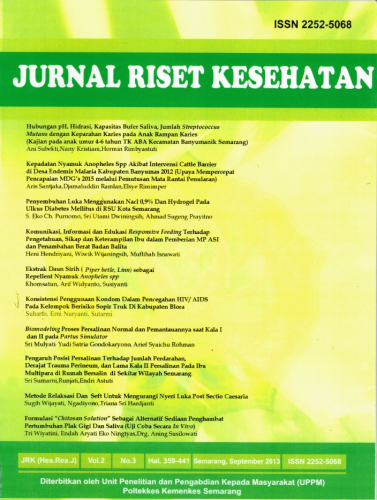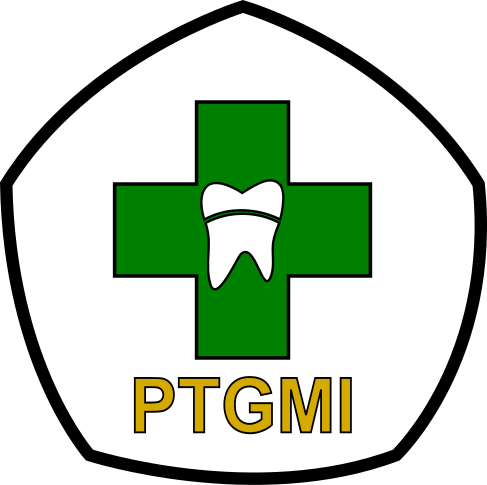RISK FACTORS THE INCIDENCE OF MALARIA IN THE DISTRICT OF KEMIRI PURWOREJO REGENCY
Abstract
Malaria is caused by protozoa of the genus plasmodium which infect red blood cells. Malaria cases in Kemiri Subdistrict, Purworejo Regency in 2006 were 13 cases and in 2016 malaria reappeared with 44 cases. The purpose of this study was to determine the risk factors associated with the incidence of malaria in Kemiri District, Purworejo Regency. The benefits of this research are adding information to the public about risk factors associated with malaria in the Kemiri District, Purworejo Regency. This type of research is observational research with analytic criteria. The variables of this study are malaria incidence and risk factors which include education, knowledge, employment, use of mosquito nets and environmental sanitation. The population and sample in this study were citizens in the Kemiri District, Purworejo Regency. Based on the results of laboratory tests all respondents (87 people) 100% tested negative for malaria. Bivariate test results showed that there was no significant relationship between the incidence of malaria with education (p=0.845), knowledge (p=0.359), community behavior (p=0.524) and environmental sanitation (p=0.095).
Keywords
Full Text:
PDFReferences
Ajami, W. A., Ottay, R. I., & Rombot, D. V. (2016). Hubungan Antara Perilaku Masyarakat dengan Kejadian Malaria di Wilayah Kerja Puskesmas Tombatu Kabupaten Minahasa Tenggara. Jurnal Kedokteran Komunitas Dan Tropik, 4(1), 65–72.
Datukramat, D., Mayulu, N., & Masi, G. (2013). Hubungan Sanitasi Lingkungan Dengan Kejadian Malaria Pada Murid Sekolah Dasar Di Kabupaten Bolaang Mongondow Utara. Jurnal Keperawatan UNSRAT, 1(1), 112522.
Dinas Kesehatan Kabupaten Purworejo. (2015). Profil Kesehatan 2014 Menuju Purworejo Sehat. http://www.depkes.go.id/resources/download/profil/PROFIL_KAB_KOTA_2014/3306_Jateng_Kab_Purworejo_2014.pdf
Dinkes Provinsi Jateng. (2019). Profil Kesehatan Provinsi Jawa Tengah Tahun 2018.
Faizah, E. N., & Fibriana, A. I. (2016). Hubungan Antara Status Medical Check Up Terhadap. Unnes Journal of Public Health, 5(1), 110–119.
Kemenkes RI. (2016). InfoDatin-Malaria-2016.pdf (pp. 1–7).
Nababan, R., & Umniyati, S. R. (2018). Analisis Spasial Kejadian Malaria Dan Habitat Larva Nyamuk Anopheles spp di Wilayah Kerja Puskesmas Winong Kabupaten Purworejo. Berita Kedokteran Masyarakat, 34(1), 11. https://doi.org/10.22146/bkm.26941
Nurmaulina, W., Kurniawan, B., & Fakhruddin, H. (2018). Hubungan Pengetahuan, Sikap dan Perilaku Penderita Malaria Falciparum Dengan Derajat Infeksi di Wilayah Kerja Puskesmas Hanura Kecamatan Teluk Pandan Kabupaten Pesawaran Provinsi Lampung Relations Between Knowledge , Attitude and Behavior to Falciparum Ma. Majority, 7(3), 34–40.
Puasa, R., H, A. A., & Kader, A. (2018). Identifikasi Plasmodium Malaria Didesa Beringin Jaya Kecamatan Oba Tengah Kota Tidore Kepulauan. Jurnal Riset Kesehatan, 7(1), 21. https://doi.org/10.31983/jrk.v7i1.3056
Supranelfy, Y., Warni, S. E., Inzana, N., &Suryaningtyas, N. H. (2018). Penemuan Kasus Malaria Berdasarkan Pemeriksaan Mikroskopis di Kota Lubuklinggau dan Kabupaten Musi Rawas. ASPIRATOR - Journal of Vector-Borne Disease Studies, 10(1), 27–36. https://doi.org/10.22435/asp.v10i1.15
DOI: https://doi.org/10.31983/jrk.v9i2.6392
Article Metrics
Refbacks
- There are currently no refbacks.
Copyright (c) 2020 Jurnal Riset Kesehatan














































